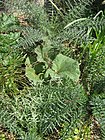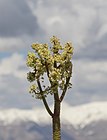Note: This is a project under development. The articles on this wiki are just being initiated and broadly incomplete. You can Help creating new pages.
Rheum ribes - Syrian rhubarb
Rheum ribes It is native Turkey, Syria, Lebanon, Iraq, Iran, Azerbaijan, Armenia to Afghanistan and Pakistan. The Syrian rhubarb a partially commercial vegetable collected from the nature in Eastern and Southern Anatolia, Northern Iraq and partly Northwestern Iran in early spring. Rheum ribes is considered as a valuable medicinal species in herbal medicine.
Uses
Parts Used
Chemical Composition
The hypoglycemic active fraction was found to contain anthraquinone glycosides of aloe emodin, emodin, physcion, and chrysophanol derivatives[1]
Common names
| Language | Common name |
|---|---|
| Kannada | |
| Hindi | |
| Malayalam | |
| Tamil | |
| Telugu | |
| Marathi | NA |
| Gujarathi | NA |
| Punjabi | NA |
| Kashmiri | NA |
| Sanskrit | |
| English | Syrian rhubarb |
Properties
Reference: Dravya - Substance, Rasa - Taste, Guna - Qualities, Veerya - Potency, Vipaka - Post-digesion effect, Karma - Pharmacological activity, Prabhava - Therepeutics.
Dravya
Rasa
Tikta (Bitter), Kashaya (Astringent)
Guna
Laghu (Light), Ruksha (Dry), Tikshna (Sharp)
Veerya
Ushna (Hot)
Vipaka
Katu (Pungent)
Karma
Kapha, Vata
Prabhava
Habit
Identification
Leaf
| Kind | Shape | Feature |
|---|---|---|
| Simple | The leaves are divided into 3-6 toothed leaflets, with smaller leaflets in between |
Flower
| Type | Size | Color and composition | Stamen | More information |
|---|---|---|---|---|
| Unisexual | 2-4cm long | Yellow | 5-20 | Flowers Season is June - August |
Fruit
| Type | Size | Mass | Appearance | Seeds | More information |
|---|---|---|---|---|---|
| 7–10 mm (0.28–0.4 in.) long pome | clearly grooved lengthwise, Lowest hooked hairs aligned towards crown | With hooked hairs | {{{6}}} |
Other features
List of Ayurvedic medicine in which the herb is used
Where to get the saplings
Mode of Propagation
How to plant/cultivate
Prefers a deep, fertile, moderately heavy, humus rich, moisture retentive, well-drained soil in sun or semi-shade[3]
Commonly seen growing in areas
Photo Gallery
References
External Links
- Ayurvedic Herbs known to be helpful to treat Heart disease
- Ayurvedic Herbs known to be helpful to treat Indigestion
- Ayurvedic Herbs known to be helpful to treat Bone problems
- Ayurvedic Herbs known to be helpful to treat Alzheimer
- Ayurvedic Herbs known to be helpful to treat Cancer
- Ayurvedic Herbs known to be helpful to treat Blotches
- Ayurvedic Herbs known to be helpful to treat Pimples
- Ayurvedic Herbs known to be helpful to treat Diarrhea
- Herbs with Leaves used in medicine
- Herbs with common name in English
- Habit - Perennial Tree
- Index of Plants which can be propagated by Seeds
- Index of Plants which can be propagated by Cuttings
- Herbs that are commonly seen in the region of At dunite rocks
- Herbs that are commonly seen in the region of Among stone area
- Herbs that are commonly seen in the region of Among slopes area
- Herbs that are commonly seen in the region of Temperate regions
- Herbs that are commonly seen in the region of Subtropical regions
- Herbs
- Ayurvedic herbs that don't have seed photos
- Polygonaceae




